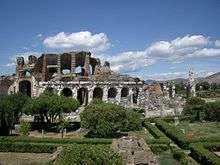Arch of Trajan (Benevento)

- For other similar structures, see Arch of Trajan
The Arch of Trajan (Italian: Arco di Traiano) is an ancient Roman triumphal arch in Benevento, southern Italy. It was erected to celebrate emperor Trajan across the Via Appia, at its entrance in the city.
History
The arch was built between 114 and 117.
In Lombard times, it was enclosed in southern sector of the city walls and became known as Porta Aurea ("Golden Gate"). The church of Sant'Ilario, now housing the Videomuseum of the Arch, was built nearby. The arch was studied by Gianmarco Serlio in Renaissance times and drawn by Giovanni Battista Piranesi in the 18th century.
It was restored several times due to aging and earthquakes: under Pope Urban VIII, then in 1661, 1713 (when the marble architrave crumbled down) and 1792. In 1850, in the occasion of Pope Pius IX's visit in Benevento, it was isolated with the demolition of the annexed structures and houses.

Description
The arch has a single, barrel-vaulted archway, and is 15.60 m-high and 8.60 m wide. Each façade has four semicolumns in correspondence of the two side pillars, supporting an entablature. Above the architraves is an attic which, like the latter, juts out above the archway.
The arch is built in limestone covered by opus quadratum with Parian marble slabs. It has a rich sculpted decoration on the two main façades. The attic features a dedicatory inscription and, at the sides, two base-relief panels: the left one on the external sides, not entirely preserved, represented the homage the provincial countryside divinities, while the right one the deduction of provincial colonies. On the internal side, on the left, was the depiction of Trajan welcomed by the Capitoline Triad and, on the right, Trajan in the Forum Boarium.
The frieze of the entablature portrays the triumph of Trajan against Dacia. On each of the pylons, between the angular semicolumns, are two superimposed panels with scenes and allegories of imperial activities (advent of Trajan, the concession of Roman citizenship to the auxiliaries, Trajan welcomed by the Senate, the Roman People and the Equestrian order and others). They are separate by lower decorative panels with Victories during sacrifices of bulls in the center and Amazons at the top.
The pendentives of the archway depict personifications of the Danube and of Mesopotamia in the external side, and the Victory and Military Loyalty on the city one, accompanied by the genii of the Four Seasons. In the arch's keys are other personification: Fortune on the external, and Rome on the city side. The internal side of the archway has two wide sculpted panels, portraying scenes of Trajan in Benevento: on the left (from inside the city) is the Sacrifice for the opening of the Via Traiana, with the emperor sided by lictors; on the right is instead the institution of the alimentaria (a beneficent institution created by Trajan to help children in Roman Italy), symbolized by pieces of bread on the table in the center, with personifications of Italic cities with children. The vault has a coffered ceiling, with, in the center, a personification of the emperor crowned by a Victory.
Sources
- Bianchi Bandinelli, Ranuccio; Mario Torelli (1976). "Etruria-Roma". L'arte dell'antichità classica. Turin: Utet. p. Arte romana 118.
Coordinates: 41°7′57.08″N 14°46′45.15″E / 41.1325222°N 14.7792083°E
| ||||||||||||||||||||||||

